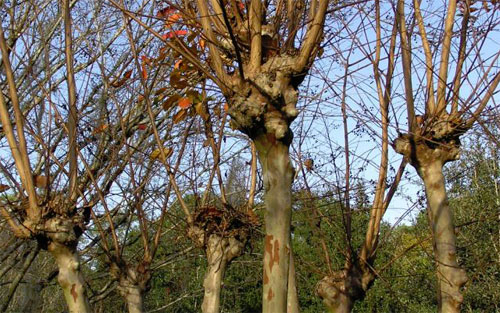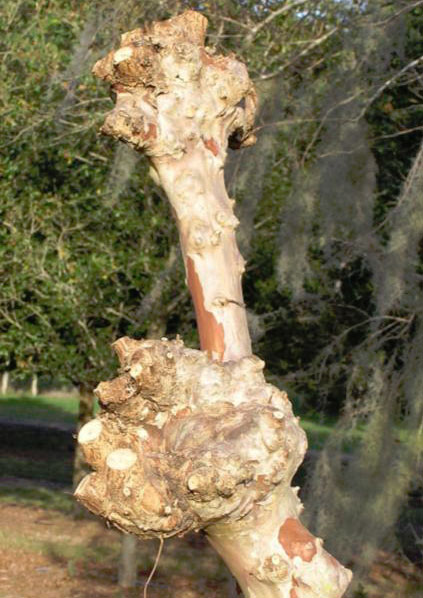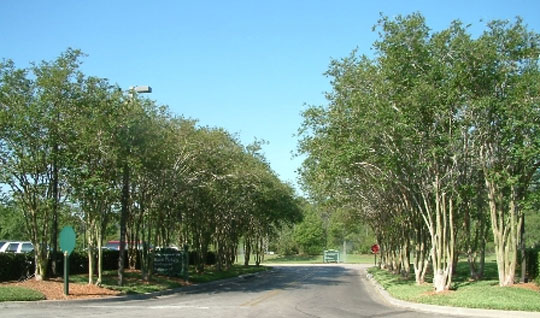Stop Crape Murder: Don’t Cut Back Your Myrtles
January 15, 2011
 Proper pruning is one of the most misunderstood of all gardening practices, yet it is one of the most important procedures in a landscape. A common victim of bad, improper pruning is the crape myrtle. Crape myrtles will occasionally need pruning to obtain the desired landscape effect, but many times these plants are butchered for no good reason.
Proper pruning is one of the most misunderstood of all gardening practices, yet it is one of the most important procedures in a landscape. A common victim of bad, improper pruning is the crape myrtle. Crape myrtles will occasionally need pruning to obtain the desired landscape effect, but many times these plants are butchered for no good reason.
According to Dan Gill, LSU AgCenter Horticulturist, an unfortunate trend in crape myrtle pruning is to lop off their tops, which results in a tree reduced to large branches ending in stubs. The lush growth that occurs at these cut sites appears vigorous but is actually structurally weak and more susceptible to fungus diseases such as powdery mildew. And when pruning is conducted improperly over several years, unsightly large, swollen knobs form at the point where pruning is done each year.
Flowers are not the only virtue of this tree. Many varieties have beautiful bark and growth habits that can be enjoyed all year if trees are not heavily pruned.
Crape murder
This unsightly, ugly pruning known as crape murder is not recommended. Once it’s done, it ruins the tree’s graceful natural shape for the rest of its life.
Often gardeners think they are supposed to prune their crape myrtles that way, and nothing could be farther from the truth. Many think that crape myrtles need to be cut way back to bloom well. This is not accurate. The flower clusters may be larger on lopped trees, but the added weight on the ends of long branches causes them to bend over awkwardly, especially after it rains. And since the tree is smaller, it actually produces fewer flower clusters.
 Many people say they need to cut a crape myrtle back because of its size. If the height of the crape myrtle is not causing a problem with a nearby structure or power lines, there is little reason to reduce the tree’s height. To cut a crape myrtle back for the vague reason of “it just seems too large” ignores the fact that these plants are trees. They are supposed to be large.
Many people say they need to cut a crape myrtle back because of its size. If the height of the crape myrtle is not causing a problem with a nearby structure or power lines, there is little reason to reduce the tree’s height. To cut a crape myrtle back for the vague reason of “it just seems too large” ignores the fact that these plants are trees. They are supposed to be large.
To prune a crape myrtle properly, first decide if it needs to be pruned. As with any pruning project, you must have a specific, valid purpose in mind before you begin. In other words, if you can’t come up with a good reason to prune your tree – leave it alone. If you do see something that calls for pruning, study the tree carefully and determine what needs to be pruned to accomplish the specific purpose identified.
There are a few valid reasons for pruning a crape myrtle. One reason is to eliminate crossed and rubbing branches because rubbing branches can lead to open wounds.
Over time, branches that are too low on the trunk will need to be pruned to raise the canopy. We often need to remove weak, thin branches from the inner part of the tree to produce a cleaner-looking tree. Selected branches may need to be pruned back to a side branch or the trunk to create a shapelier tree. Of course, you need to prune to keep suckers removed from the base of the trunk.
 Generally, avoid cutting back or shortening branches much larger than your finger, although cutting larger branches back to a side branch or to the trunk when needed is fine.
Generally, avoid cutting back or shortening branches much larger than your finger, although cutting larger branches back to a side branch or to the trunk when needed is fine.
Visitors to our area often marvel over our crape myrtles. During summer, their colorful flowers, attractive bark and beautiful shape make them among our most valuable landscape plants. Please appreciate this – and stop the unfortunate trend of hacking them back.
Theresa Friday is the Residential Horticulture Extension Agent for Santa Rosa County.
Pictured top: Crape myrtle trees do not need pruning for new growth. Pictured below: These Crape myrtles were ruined with unnecessary topping. Submitted photos for NorthEscambia.com.
Comments
10 Responses to “Stop Crape Murder: Don’t Cut Back Your Myrtles”





The City of Atmore had the most beautiful Crepe Myrtles on Hwy 21 and they were kept the way they were supposed to be but the Hwy Dept. made them cut them down a few years back. I thought that was such a terrible thing because they really enhanced the highway coming into Atmore and people traveling thru Atmore to I-65.
Just my opinion.
REGARDING:
“How does one propagate the crape myrtle?”
I was always told, cut a piece, stick it in the ground, remember not to mow it down as it grows and you are finished.
For more detailed instructions from http://www.ehow.com/how_4480829_grow-crape-myrtle-from-cutting.html
Obtain the Cutting
•1 Cut the soft, new growth if you are collecting cuttings in May or June. From July to early fall, collect the hardwood growth. Morning is the best time to collect cuttings while the tree is fairly dormant.
•2 Use a sharp clean cutting tool to avoid spreading diseases to the plant. Pruners usually work well. Cuttings should be about five to seven inches long and no thicker than your pinky finger.
•3 Immediately, wrap the cuttings in wet paper towels and place in a plastic bag until you can get them into the planning medium. Don’t leave the cuttings in the bag long or they may mold.
Plant the Cutting
•1 Try commercial root hormone to encourage new growth, but crape myrtle will root well without it.
•2 Use a commercial planting medium or make your own from equal parts of peat and sand. Use a container that drains well and is big enough for growing roots.
•3 Insert two to three inches into the planting medium with the buds pointing up.
(there’s more)
Just remember, the growth hormone is optional and the cuttings are plentiful, get as many as you wish from my house, I never cut them back and have a sizeable one mixed with a Hawthorne out by Bluff Springs Road, easy to get to more elsewhere.
Take a hundred cuttings, if only ninety percent live, you’ll have ninety trees.
David for sharing
listening,
My friend told me to bore down around (with a metal pole or similar) the ground by the trunk in several places and fertilize them every year. Floral Tree Gardens on Hwy. 29 should be able to tell you the specific fertilizer needed.
I have really learned a lot this year about pruning from this friend.
This is just one man’s opinion. I have crepes in my yard, pruned every year, and I am constantly given compliments on them. The ones in my yard are so beautiful, the other neighbors planted crepes to mimic them. Of course, if you don’t prune them properly, the tree will look unsitely. And I believe, once they reach a certain height (i.e. the ones pictured above), leave them alone, or you will make them look gangly. Also, keep the suckers cut back, and fertilize well.
Someone should send this article to the Es. Co. Public Schools. The ones at Ransom were just butchered.
mine are not growing or filling out very well…they are only approx. 5-7 yrs old….how do I help them?
David…….I propagated a few last year from our large one by hanging a lightweight container of dirt in a sturdy branch and laying one of the smaller branches in the dirt while it was still attached to the tree. I weighted it down to keep it in the dirt, and a few weeks later, it had rooted. Of course, you can do the same with a low limb close to the ground.
William……thanks for this article. I have never cut mine back at the top, but this year, I need to “shape” one that is starting to hang over our roof on one side, and I needed this info.
Great article William. Once again you have provided me with information that I will be able to use in Feb’. Due to the past theory that these need to be cut every year, this should open a few eyes to one of the prettiest trees you’ve ever seen in full bloom. Keep up the good work.
How does one propagate the crape myrtle?
Who prunes/murders the crepe myrtles for Es.Co. Public Schools? A few years ago they looked pretty awful at Jim Allen Elementary School but the ugliest I’ve ever seen are those poor ugly trees at Cordova Park Elementary School. The base of the trees look like they’ve been in the ocean and got covered in barnacles.